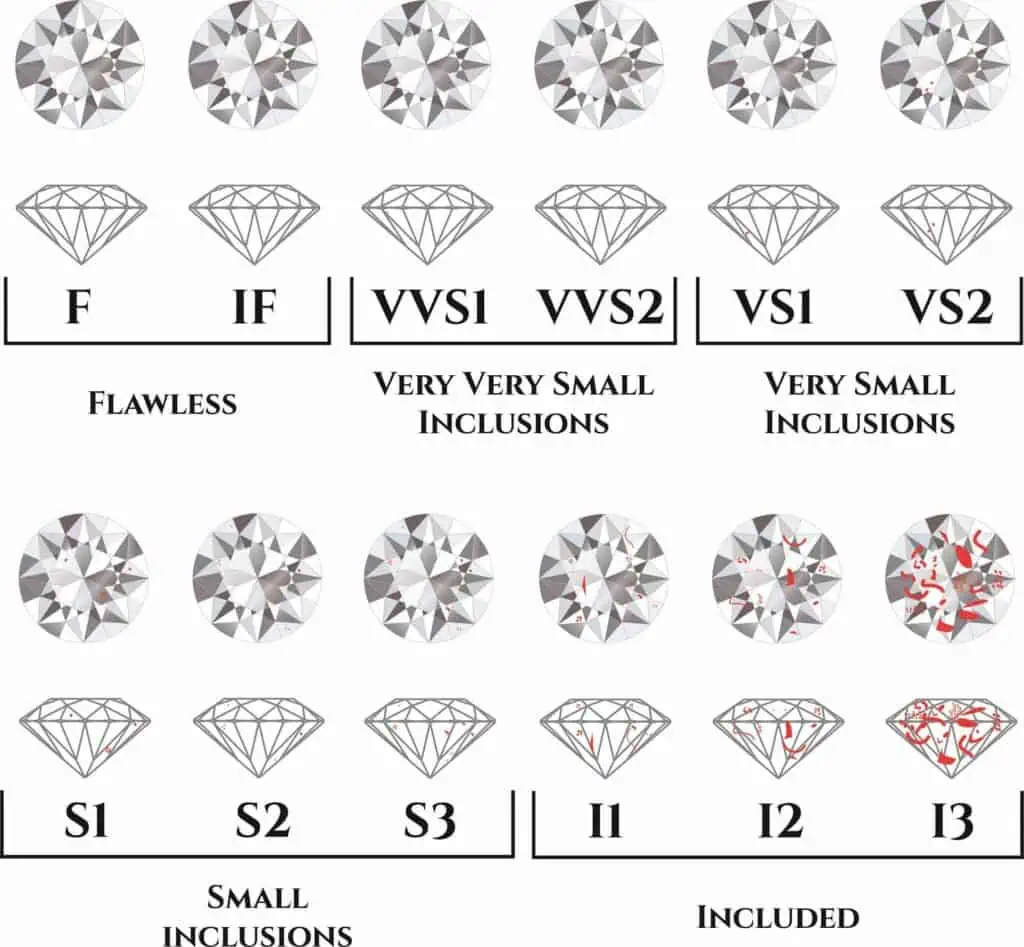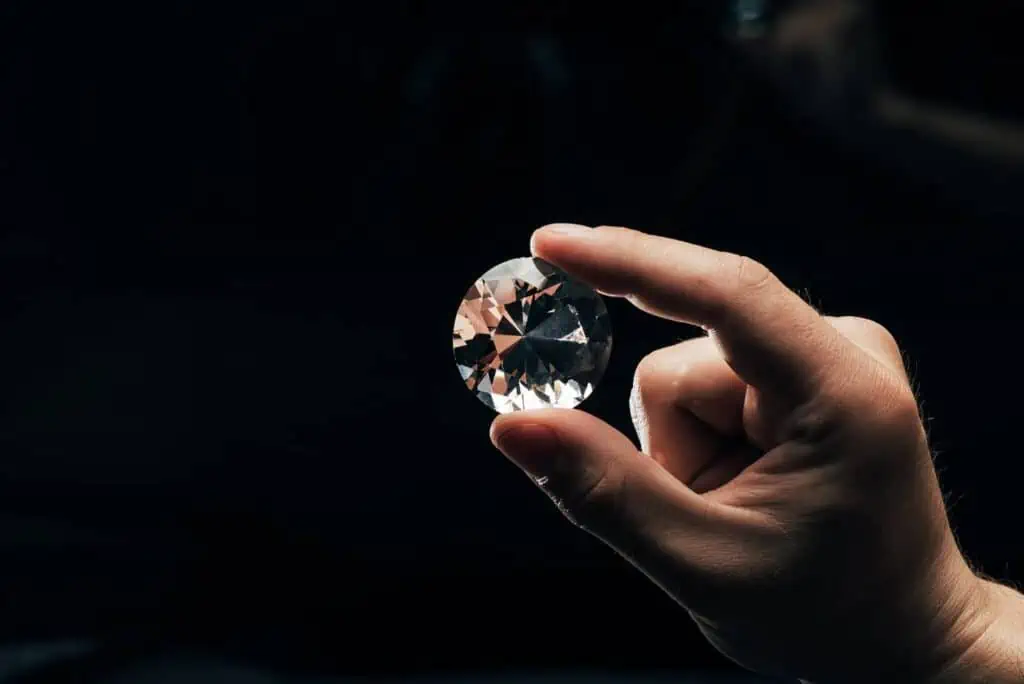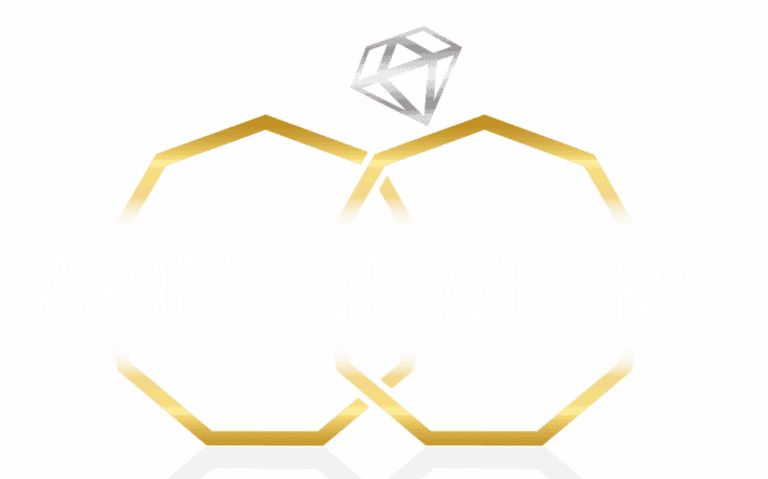We're celebrating our new website -
and you get. . .
and you get. . .
A special 10% Off!
Simply enter LAUNCH10 at checkout to redeem your discount. Don’t miss out on this limited time offer!

Diamonds are some of the most sought-after gemstones in the world, and for good reason. Not only are they incredibly beautiful, but they also symbolize love, commitment, and luxury. That’s exactly why Diamond rings are the best go-to jewelry for the loving couple, either as a wedding ring or an engagement one.
However, like human beings, not all diamonds are created equal. Whether it’s a natural diamond or lab-grown one, understanding the role of diamond clarity and inclusions in diamond is key to making an informed purchase.
Here, we’d like to explore what diamond flaws are, how they affect a diamond’s overall appearance and value – and their importance in relation to a diamond spark.
Understanding diamond clarity is essential when it comes to selecting the perfect diamond. As we mentioned in our Diamond Characteristics: The 5 Cs You Have to Know article, Clarity has one of the major impacts on a diamond appearance, spark & value.
“Diamond clarity” refers to the presence of any internal or external characteristics, known as diamond flaws. These flaws can range from tiny inclusions to large blemishes, and can greatly affect a diamond’s transparency, making it between “crystal clear” or “cloudy”. The scale to measure it, professionally, goes from Included (marked with “I”) to Flawless (marked with “F”).
Now, while some people may assume that a flawless diamond must be the best choice, it’s important to know that the presence of some inclusions may be acceptable and have minimal impact on a diamond’s beauty. That’s depending on its color & cut, in addition to its clarity.
Since the way that light interacts with the way light reflects off a diamond, its facets (or: cut) are crucial to its overall sparkle.
So the question that many wonder is, eventually: which diamond cut sparkles the most?
While all diamond cuts are beautiful in their own way, certain cuts are known to maximize sparkle and fire. That’s thanks to their shape and the ability to reflect light. The round brilliant cut, for example, is a leading light-reflector due to its numerous facets facing every direction. With it, on the list of most sparkly diamond cut, we have the radiant cut and the oval cut with those same characteristics.
Going through our engagement rings catalog, you can filter rings by shape to go straight to the sparkliest!
However, as we mentioned, the way that light interacts with a diamond does not depend solely on its cut, as clarity characteristics play a major role as well. Inclusions may prevent its shape from reflecting light correctly. So along with diamond cut, we must consider the diamond flaws as well.
When it comes to diamond clarity, both radiant and oval diamonds can be excellent choices. However, radiant diamonds are typically cut with many facets, which can help to hide any clarity characteristics or inclusions in the diamond. Oval diamonds, on the other hand, are cut with fewer facets, which can make any inclusions or flaws more noticeable. However, when it comes to sparkle and brilliance, oval diamonds often have a more elongated shape that can create a beautiful, dazzling effect – making it the best diamond cut for sparkle. Ultimately, the choice between radiant vs oval diamond will depend on personal preference, budget and desires. But it’s important to work with a reputable jeweler to select a high-quality diamond with minimal inclusions or flaws, considering diamond clarity.

As a jewelry designer, it’s crucial to take notice of diamond clarity characteristics when selecting the perfect stone for a customer’s jewelry. As a customer, it is important to know which clarity characteristics are those your designer takes to consider. Understanding this concept will help you better understand diamond-choosing for your ring or earrings.
Clarity characteristics refer to the tiny imperfections, or inclusions, that can be found within a diamond. These inclusions can be anywhere between untraceable and naked-eye visible, and impact the diamond’s appearance and value. This makes them an essential factor to consider when making a purchase. Even minor details of polish can affect clarity characteristics, so it’s essential to inspect a diamond closely to understand its true clarity.
When examining a diamond with the best clarity, there are several characteristics to look for. In general, clarity characteristics can include blemishes which are found on a diamond’s surface, or inclusions within the diamond itself. Some common inclusions (which have explanatory names) include feathers, crystals, and clouds, which can impact the diamond’s structural integrity and, therefore, its overall clarity and value.
Meaning: instead of seeing clear through it, you see feathers, crystals, or clouds.
One specific clarity characteristic to be aware of is the clarity characteristics cloud. This cloudiness can give the diamond a hazy or “milky” appearance, diminishing its overall sparkle and brilliance. Understandably, clouds have a major effect on diamond clarity.
Understanding this effect is vital to know the impact on your diamond and its value.
Should you buy a cloudy diamond? Well, that depends how cloudy it is, and what’s the final budget that you have.
Should you pay less if your diamond is cloudy? Yes. Of course. The value of a cloudy diamond would let you pay less since it’s a less clear stone.
Another essential aspect of clarity characteristics is knowing which ones to avoid. For example, inclusions that are likely to impact a diamond’s structural integrity can be problematic, as they can compromise the diamond’s overall quality and value. Some inclusions might be located in the center of the diamond, and even then they can be problematic. Since they can impact the diamond’s sparkle and overall appearance – worse inclusions negatively affect clarity and value.
By understanding what to look for and what to avoid, you can select a diamond that has the ideal clarity characteristics for your ring or jewelry.
Diamond inclusion refers to the internal characteristics of a diamond that can affect its appearance and value. Understanding the different diamond inclusion types is important in diamond selection as it can greatly impact the overall quality and beauty of your stone, and the price you pay for it. There are various types of diamond inclusions, mostly including: chips, feathers, clouds, and more.
Each of these inclusions can vary in size, shape, and color, and can have a different impact on the diamond’s integrity.
Of course it’s a scale; some inclusions can be more problematic than others, whilst some are not hurtful. It’s important to avoid those that could significantly affect the diamond’s beauty and durability.
Here’s the full list:
Clouds are clusters of tiny, pinpoint-sized inclusions that can appear like a cloud inside the diamond. They are usually not visible to the naked eye, but can affect the diamond’s transparency and brightness since they’re blocking light from going freely through the diamond.
Feathers are cracks that look like feathers or wisps inside the diamond. They can vary in size, from small and insignificant to large and noticeable. Large feathers can affect the diamond’s durability and make it more prone to chipping or breaking – which obviously downgrades its value.
Pinpoints are small inclusions that look like tiny dots inside the diamond. They can be black, white or colored and are usually not visible to the naked eye. They can, however, affect the diamond’s clarity and overall appearance. This would also affect its market value.
Knots are crystals that extend to the surface of the diamond. They can be visible as small white or transparent spots on the surface of the diamond. They also affect diamond’s durability so that critical knots can lead to breaking or chipping.
Cavities are holes or voids inside the diamond. They can be caused by a variety of factors, including natural inclusions from heat or pressure, or even poor polishing. Sometimes, damage is being done to the diamond during the cutting process.
Large cavities can affect the diamond’s durability and its survivability.
Chips are small breaks or nicks on the surface of the diamond. They can be caused by wear and tear, damage during the cutting process, or accidental strong impacts. Large sizes or quantities of chips can critically affect diamond’s durability.
When evaluating a diamond for purchase, it’s important to consider the type and severity of any inclusions present, as they have a significant impact on the diamond’s overall quality, value and durability.
In general, when it comes to diamond flaws, it’s best to choose stones that have fewer and less noticeable inclusions. That way you can ensure the highest quality and value. By understanding the different types of diamond inclusions, you’ll make an informed decision about your diamond. So now you can choose one diamond that is both beautiful and durable.

Well, when it comes to the big question of bigger diamond or better clarity, the obvious answer is… depended. A larger diamond may be more impressive at first glance, but if it’s not of higher quality/clarity it’s inclusions might be very noticeable. In contrast, a diamond with better clarity may not be as large but will have fewer visible flaws or inclusions, which greatly impacts its overall beauty and value – making it sparklier.
So selecting a diamond should take in account a striking balance between size and clarity to best fit your taste and budget. It’s worth noting that diamonds are graded on a variety of factors, including cut, color, carat weight, and clarity, so it’s important to consider all these when making a smart purchase decision. More of it on our 5C’s of Diamonds article.
Our newsletter is the perfect mixture between professional good-to-knows and occasional deal & coupons.
Want just one or the other? Join us. You’ll get exactly what you want.

Boutique, family owned, handcrafted Jewelry Design team.
Between quality materials, impeccable design and personal customer service —
We choose all.
We are here for you call US:
+1 (917)-477-8663

If you would like to measure your ring size immediately the quickest ways and with an accurate fit – you can do it with our Ring Size Chart here.
The way to quickly get your measurements is either going to the nearest jewelry shop and ask them to measure you, or to buy a Ring Sizer Measuring Gauge with a 2-day delivery to the US!
Then you can match your measurement to the size chart below to get your exact ring size.
A few factors we recommend to consider for the perfect measure:
Still not sure what your size is or what to choose for your love one? We’re here to help!
| MM | Inches | MM | Inches | UK/AU | US & Canada & Mexico | France | Germany & Russia & Ukraine & Asia | India & China & Japan & South America | Italy & Spain & Netherlands & Switzerland |
| 14.05 | 0.553 | 44.14 | 1.74 | F | 3 | 44 | 14 | 4 | 4 |
| 14.25 | 0.561 | 44.77 | 1.76 | F 1/2 | 3.25 | 44.625 | 14.25 | 4.5 | 4.625 |
| 14.45 | 0.569 | 45.4 | 1.79 | G | 3.5 | 45.25 | 14.5 | 5 | 5.25 |
| 14.65 | 0.577 | 46.02 | 1.81 | H | 3.75 | 45.875 | 14.75 | 6 | 5.875 |
| 14.86 | 0.585 | 46.68 | 1.84 | H 1/2 | 4 | 46.5 | 15 | 7 | 6.5 |
| 15.04 | 0.592 | 47.25 | 1.86 | I | 4.25 | 47.125 | 15.25 | 7.5 | 7.125 |
| 15.27 | 0.601 | 47.97 | 1.89 | I 1/2 | 4.5 | 47.75 | 15.5 | 8 | 7.75 |
| 15.53 | 0.611 | 48.79 | 1.92 | J 1/4 | 4.75 | 48.375 | — | 8.5 | 8.375 |
| 15.7 | 0.618 | 49.32 | 1.94 | J 1/2 | 5 | 49 | 15.75 | 9 | 9 |
| 15.9 | 0.626 | 49.95 | 1.97 | K 1/4 | 5.25 | 49.625 | 16 | 9.5 | 9.625 |
| 16.1 | 0.634 | 50.58 | 1.99 | L | 5.5 | 50.25 | 16.25 | 10 | 10.25 |
| 16.3 | 0.642 | 51.21 | 2.02 | L 1/4 | 5.75 | 50.875 | — | 11 | 10.875 |
| 16.51 | 0.65 | 51.87 | 2.04 | M | 6 | 51.5 | 16.5 | 12 | 11.5 |
| 16.71 | 0.658 | 52.5 | 2.07 | M 1/2 | 6.25 | 52.125 | 16.75 | 12.5 | 12.125 |
| 16.92 | 0.666 | 53.16 | 2.09 | N | 6.5 | 52.75 | 17 | 13 | 12.75 |
| 17.13 | 0.674 | 53.82 | 2.12 | N 1/2 | 6.75 | 53.375 | — | 13.5 | 13.375 |
| 17.35 | 0.683 | 54.51 | 2.15 | O | 7 | 54 | 17.25 | 14 | 14 |
| 17.45 | 0.687 | 54.82 | 2.16 | O 1/2 | 7.25 | 54.625 | 17.5 | 14.5 | 14.625 |
| 17.75 | 0.699 | 55.76 | 2.2 | P | 7.5 | 55.25 | 17.75 | 15 | 15.25 |
| 17.97 | 0.707 | 56.45 | 2.22 | P 1/2 | 7.75 | 55.875 | — | 15.5 | 15.875 |
| 18.19 | 0.716 | 57.15 | 2.25 | Q | 8 | 56.5 | 18 | 16 | 16.5 |
| 18.35 | 0.722 | 57.65 | 2.27 | Q 1/2 | 8.25 | 57.125 | 18.25 | 16.5 | 17.25 |
| 18.53 | 0.729 | 58.21 | 2.29 | Q 3/4 | 8.5 | 57.75 | 18.5 | 17 | 17.75 |
| 18.69 | 0.736 | 58.72 | 2.31 | R 1/4 | 8.75 | 58.375 | 18.75 | 17.5 | 18.375 |
| 18.89 | 0.748 | 59.34 | 2.35 | R 3/4 | 9 | 59 | 19 | 18 | 19 |
| 19.22 | 0.757 | 60.38 | 2.38 | S 1/4 | 9.25 | 59.625 | 19.25 | 18.5 | 19.625 |
| 19.41 | 0.764 | 60.98 | 2.4 | S 3/4 | 9.5 | 60.25 | 19.5 | 19 | 20.25 |
| 19.62 | 0.772 | 61.64 | 2.43 | T 1/4 | 9.75 | 60.875 | 19.75 | 19.5 | 20.875 |
| 19.84 | 0.781 | 62.33 | 2.45 | T 1/2 | 10 | 61.5 | 20 | 20 | 21.25 |
| 20.02 | 0.788 | 62.89 | 2.48 | U | 10.25 | 62.125 | 20.25 | 21 | 22.125 |
| 20.2 | 0.797 | 63.46 | 2.5 | U 1/2 | 10.5 | 62.75 | 20.5 | 22 | 22.75 |
| 20.44 | 0.805 | 64.21 | 2.53 | V 1/4 | 10.75 | 63.375 | — | 22.5 | 23.375 |
| 20.68 | 0.814 | 64.97 | 2.56 | V 1/2 | 11 | 64 | 20.75 | 23 | 24 |
| 20.85 | 0.821 | 65.5 | 2.58 | W 1/4 | 11.25 | 64.625 | — | 23.5 | 24.625 |
| 21.08 | 0.83 | 66.22 | 2.61 | W 3/4 | 11.5 | 65.25 | 21 | 24 | 25.25 |
| 21.24 | 0.836 | 66.73 | 2.63 | X 1/4 | 11.75 | 65.875 | — | 24.5 | 25.875 |
| 21.49 | 0.846 | 67.51 | 2.66 | Y | 12 | 66.5 | 21.25 | 25 | 26.5 |
| 21.69 | 0.854 | 68.14 | 2.68 | Y 1/2 | 12.25 | 67.125 | 21.5 | 25.5 | 27.125 |
| 21.89 | 0.862 | 68.77 | 2.71 | Z | 12.5 | 67.75 | 21.75 | 26 | 27.75 |
| 22.1 | 0.87 | 69.43 | 2.73 | Z +1/2 | 12.75 | 68.375 | — | 26.5 | 28.375 |
| 22.2 | 0.75 | 70 | 2.74 | Z+1 | 13 | 69 | 22 | 27 | 29 |
Simply enter LAUNCH10 at checkout to redeem your discount. Don’t miss out on this limited time offer!